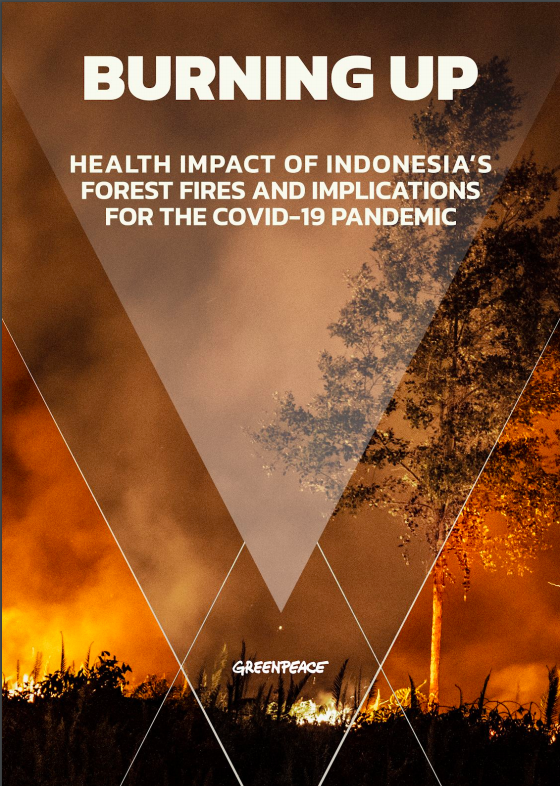Executive Summary
As Indonesia braces for the 2020 forest fire season, a timely review of data of the effect on smoke-affected communities shows consecutive governments have been consistently and massively underestimating the impact on human health. The review also presents compelling evidence from research, indicating that the risk and severity of infection from Covid-19 may significantly increase amongst already vulnerable communities exposed to high levels of air pollution.
For almost four decades the toxic smoke and air pollution from yearly forest and peatland fires have exacted a huge toll on the communities, biodiversity, environment and economy of Indonesia and its neighbouring countries.
Successive governments have considerably downplayed the scale of the impact on human health. After the devastating 2015 fire season, the official death toll was put at just 24 lives lost. In contrast, epidemiologists estimate tens of thousands of people died; monitoring reports note the fires had created “perhaps the worst sustained air quality ever recorded worldwide”; and other researchers calculated tens of millions of people had been exposed to levels of air pollution ranging from ‘unhealthy’ to ‘hazardous’.
The health of people across the ASEAN region has been damaged and many thousands have died prematurely, because of exposure that could have been avoided. Commercial activity, particularly forest clearing and peatland draining by the palm oil, pulp and paper industries has dried out huge swathes of the Indonesian landscape, creating the perfect conditions for fires to take hold. Despite having the authority to prevent this devastating process, the Indonesian government has consistently enabled the industry to continue down this destructive path.
Studies have found that fires in Indonesia’s peatlands, which account for nearly half the burnt land in commercial concessions, produce pollution which is particularly damaging to health. The peatland blazes create a larger proportion of fine particles (PM2.5) than other forest fires. These particles, 30 times smaller than a human hair, are more easily absorbed and damaging to human health.
The damage to health from forest fire air pollution has been long documented. However, official monitoring of air quality remains entirely inadequate in Indonesia. Pollution monitoring in neighbouring countries is considerably more widespread and reliable. A combination of data from other countries, as well as accurate modelling studies has provided compelling evidence of large-scale health impacts across the region.
By examining the available data and literature, clear commonalities have also emerged between the health impacts of exposure to air pollution and vulnerabilities related to the Covid-19 pandemic.
In addition to causing serious health conditions such as chronic lung conditions, increased respiratory infections and cardiovascular disease, there is now a growing body of evidence that suggests air pollution could increase the chance of Covid-19 infection and exacerbate the severity of the infection for those already Covid-19 positive.
Research carried out earlier this year in China found exposure to air pollution was significantly higher in Covid-19 positive patients. It has been established that Covid-19 positive patients with certain ‘preexisting’ or underlying conditions, such as diabetes, hypertension, cardiovascular disease, and chronic lung conditions including asthma and chronic obstructive pulmonary disease, are at greater risk of being hospitalised and even dying. Many of the same conditions are caused by or worsened by forest fires – including pollution from the blazes occurring repeatedly in Indonesia.
While earlier studies highlighted the elderly as at particular risk from both forest fire pollution and Covid-19 infection, one new study has also highlighted the risks posed to the next generation from recurring forest fires. Children exposed at a young age to smoke through living in Sumatra or Kalimantan during the 1997 fires were examined over subsequent years and showed lower grades of completed schooling, lower scores in cognitive tests, and slower physical growth than children who were not smoke-exposed. The children’s lower height and weight for age is an indicator of poor health. This study data is particularly concerning given the findings of the Indonesian Paediatrician Association, which has blamed poor health among impoverished children for Indonesia recording among the world’s highest child Covid-19 death rates – 51 fatalities reported in July and double the figure by the following month.
The case for immediate and decisive action to end Indonesia’s fires crisis cannot be disputed. Successive studies, over decades, have uncovered the impact on the biodiversity of the region. Carbon emissions are altering the climatic patterns which affect Indonesia’s dry season, worsening fires and making them more frequent, which in turn releases more emissions and accelerates climate change. The massive economic cost of continuing to create the conditions for these fires runs into billions of dollars.
However, this distillation of evidence clearly points to forest fires also being a major public health crisis, one that risks being compounded by the global Covid-19 pandemic.
A range of industry commitments and government regulations are already in place, which need to be strengthened further, but even in their current form would already reduce the incidence of fires. It is vital that the Indonesian government enforce those regulatory controls, prevent clearing and draining of forest and peatlands; hold accountable the industries continuing to act with impunity; and ensure that public health is prioritised over corporate profit.

